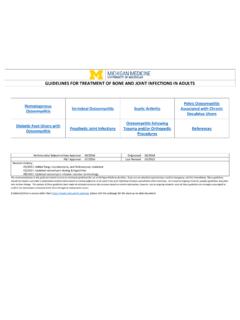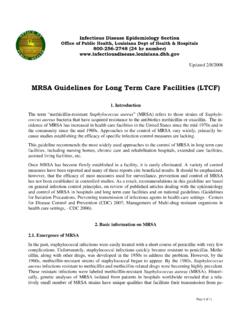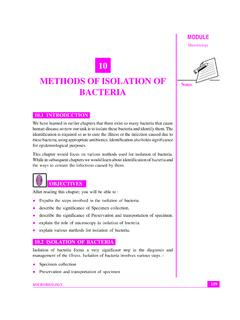Transcription of Diagnosis and Management of Acute Pyelonephritis in Adults
1 See page 835 for strength-of-recommendation labels. Acute Pyelonephritis is an infection of the upper urinary tract, specif-ically the renal parenchyma and renal pelvis (Figure 1). Acute Pyelonephritis is considered uncomplicated if the infection is caused by a typical patho-gen in an immunocompetent patient who has normal urinary tract anatomy and renal function. Misdiagnosis can lead to sepsis, renal abscesses, and chronic Pyelonephritis that may cause secondary hypertension and renal failure. Risk factors for complicated Acute Pyelonephritis are those that increase susceptibility or reduce host response to infections (Ta b l e 1).1,2 Approximately 250,000 cases of Acute Pyelonephritis occur each year, resulting in more than 100,000 Women are approximately five times more likely than men to be hospitalized with this condition ( versus hos-pitalizations per 10,000 cases, respectively); however, women have a lower mortality rate than men ( versus deaths per 1,000 cases, respectively).
2 4 Acute Pyelonephritis occurs in 1 to 2 percent of pregnant women, increasing the risk for premature labor and low-birth-weight PathogenesisMost renal parenchymal infections occur secondary to bacterial ascent through the urethra and urinary bladder. In men, pros-tatitis and prostatic hypertrophy causing urethral obstruction predispose to Hematogenous Acute Pyelonephritis occurs most often in debilitated, chronically ill patients and those receiving immunosup-pressive therapy. Metastatic staphylococcal or fungal infections may spread to the kidney from distant foci in the bone or skin. In more than 80 percent of cases of Acute Pyelonephritis , the etiologic agent is Escher ichia Other etiologic causes include aerobic gram-negative bacteria, Staphylo coccus saprophyticus, and enterococci. The microbial spectrum associated with different types of urinary tract infections (UTIs) is There are approximately 250,000 cases of Acute Pyelonephritis each year, resulting in more than 100,000 hospitaliza-tions.
3 The most common etiologic cause is infection with Escherichia coli. The combination of the leukocyte esterase test and the nitrite test (with either test proving positive) has a sensitivity of 75 to 84 percent and a specificity of 82 to 98 percent for urinary tract infection. Urine cultures are positive in 90 percent of patients with Acute Pyelonephritis , and cultures should be obtained before antibiotic therapy is initiated. The use of blood cultures should be reserved for patients with an uncertain Diagnosis , those who are immunocompromised, and those who are suspected of having hematogenous infections. Outpatient oral antibiotic therapy with a fluoroquinolone is successful in most patients with mild uncomplicated Pyelonephritis . Other effective alternatives include extended-spectrum penicillins, amoxicillin-cla-vulanate potassium, cephalosporins, and trimethoprim-sulfamethoxazole.
4 Indications for inpatient treatment include complicated infections, sepsis, persistent vomiting, failed outpatient treatment, or extremes of age. In hospitalized patients, intravenous treatment is recommended with a fluoroquinolone, aminoglycoside with or without ampicillin, or a third-generation cephalosporin. The standard duration of therapy is seven to 14 days. Urine culture should be repeated one to two weeks after completion of antibiotic therapy. Treatment failure may be caused by resistant organ-isms, underlying anatomic/functional abnormalities, or immunosuppressed states. Lack of response should prompt repeat blood and urine cultures and, possibly, imaging studies. A change in antibiotics or surgical intervention may be required. (Am Fam Physician 2005;71:933-42. Copyright 2005 American Academy of Family Physicians.) Diagnosis and Management of Acute Pyelonephritis in AdultsKALYANAKRISHNAN RAMAKRISHNAN, , and DEWEY C.
5 SCHEID, , University of Oklahoma Health Sciences Center, Oklahoma City, OklahomaMarch 1, 2005 Volume 71, Number 5 American Family Physician 933In more than 80 percent of cases of Acute pyelonephri-tis, the etiologic agent is Escherichia coli. Downloaded from the American Family Physician Web site at Copyright 2005 American Academy of Family Physicians. For the private, non commercial use of one individual user of the Web site. All other rights reserved. Contact for copyright questions and/or permission is a corrected version of the article that appeared in American Family Physician Volume 71, Number 5 March 1, 2005wide (Ta b l e 2).8,9 In elderly patients, E. coli is a less common (60 percent) cause of Acute Pyelonephritis . The increased use of cath-eters and instruments among these patients predisposes them to infections with other gram-negative organisms such as Proteus, Klebsiella, Serratia, or who have diabetes mellitus tend to have infections caused by Klebsiella, Enterobacter, Clostridium, or Candida.
6 They also are at an increased risk of develop-ing emphysematous Pyelonephritis and pap-illary necrosis, leading to shock and renal ,10 Bacteriuria, which frequently is polymicrobial, develops in more than 50 percent of patients who require catheter-ization for more than five days, and in virtu-ally all patients who have indwelling urinary catheters for more than one favors the develop-ment of subclinical (silent) Pyelonephritis and infections caused by nonenteric, aero-bic, gram-negative rods and Candida. Acute Pyelonephritis occurs within two months following renal transplant in 30 to 50 per-cent of patients because of concomitant immunosuppression and postsurgical vesi-coureteric ref Acute Pyelonephritis is considered complicated in men because they have a higher probability of urinary tract abnormalities, prostatic enlargement caus-ing urethral obstruction with incomplete voiding, or an age-related decrease of anti-bacterial activity in prostatic PresentationThe spectrum of Acute Pyelonephritis is wide, ranging from a mild illness to sepsis To diagnose Acute pyelonephri-Strength of RecommendationsKey clinical recommendationLabelReferencesBlood cultures should be obtained in patients with Acute Pyelonephritis only if there is diagnostic uncertainty, the patient is immunosuppressed, or a hematogenous source is suspected.
7 C24, 25 Outpatient oral therapy is successful in 90 percent of selected patients with uncomplicated Acute Pyelonephritis who can tolerate oral intake, will be compliant with the treatment regimen, will return for early follow-up, and have adequate social support. B27, 28 Patients hospitalized with Acute Pyelonephritis should be treated with one of three initial intravenous therapies: a fluoroquinolone; an aminoglycoside with or without ampicillin; or an extended-spectrum cephalosporin with or without an 29 A = consistent, good-quality patient-oriented evidence; B = inconsistent or limited-quality patient-oriented evidence; C = consensus, disease-oriented evidence, usual practice, opinion, or case series. See page 835 for more 1. Anatomy of the BY DAVID KLEMM Renal pyramidsRenal pelvisUreterRenal cortexRenal medullaCapsuleMarch 1, 2005 Volume 71, Number 5 American Family Physician 935 Pyelonephritistis, physicians must rely on evidence of UTI from urinalysis or culture, along with signs and symptoms suggesting upper UTI (fever, chills, f lank pain, nausea, vomiting, costo-vertebral angle tenderness).
8 Symptoms that are suggestive of cystitis (dysuria, urinary bladder frequency and urgency, and supra-pubic pain) also may be a study11 of young and middle-aged women presenting to an emergency depart-TABLE 2 Microbial Organisms Causing Specific Types of urinary Tract Infections Microbial organismAcute uncomplicated cystitis (%)* Acute uncomplicated Pyelonephritis (%) Complicated UTI (%) Catheter-associated UTI (%)Escherichia coli68893224 Staphylococcus saprophyticus8010 Proteus6446 Klebsiella4458 Enterococci30227 Pseudomonas00209 Mixed351011 Yeast00158 UTI = urinary tract infection.* One study9 showed that 25 percent of E. coli isolates were resistant to ampicillin, 24 percent to tetracyclines, and 11 percent to trimethoprim-sulfamethoxazole (TMP-SMX; Bactrim, Septra).Adapted with permission from The Johns Hopkins Ambulatory Clerkship in Medicine. Dysuria. Accessed online December 5, 2004, at.
9 , with additional information from reference 1 Risk Factors for Complicated Acute PyelonephritisAgeImmunosuppressed stateObstructionInfantsDiabetes mellitusForeign bodyElderly (> 60 years of age)Sickle cell diseaseCalculiAnatomic/functional abnormalityTransplantationBladder neck obstructionPolycystic kidney diseaseMalignancyPosterior urethral valveHorseshoe kidneyChemoradiationBenign prostatic hypertrophyDouble ureterHIV infectionsNeurogenic bladderUreteroceleCorticosteroid usePregnancyVesicoureteric refluxMale sexMiscellaneousForeign bodyAnatomic abnormalitiesInappropriate antibioticsUrinary, ureteric, or nephrostomy cathetersProstatic obstructionResistant organismsInstrumentationCalculus HIV = human immunodeficiency from references 1 and American Family Physician Volume 71, Number 5 March 1, 2005ment with fever, pyuria, and other features of upper UTI, 98 percent had Acute pyelo-nephritis.
10 In the absence of fever, 16 percent were given alternative However, up to one third of elderly patients with Acute Pyelonephritis have no fever; in 20 percent of elderly patients, the predominant symptoms are gastrointestinal or Fever and leukocytosis are of little value in diag-nosing Acute Pyelonephritis in patients who have indwelling bladder catheters, especially when infections are caused by gram-positive cocci or The differential diagno-sis of Acute Pyelonephritis includes pelvic inf lammatory disease, cholecystitis, appen-dicitis, lower lobe pneumonia, perforated viscus, and the prodrome of herpes to 30 percent of women presenting with cystitis-like symptoms have upper urinary tract involvement (subclinical Pyelonephritis ), but these infec-tions rarely cause any cortical damage. This situation is more common in pregnant women and patients with recurrent UTI, diabetes, immunosuppression, renal tract pathology, or previ-ous UTI occurring before 12 years of In the presence of obstruction (stone, tumor, bladder neck obstruction, enlarged prostate), Acute Pyelonephritis can be extremely severe and recalcitrant to treatment, and may prog-ress to renal abscess.















